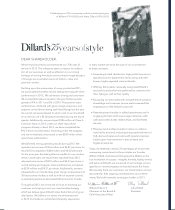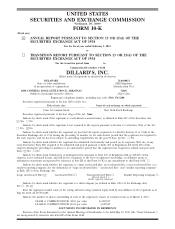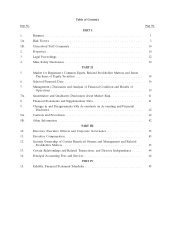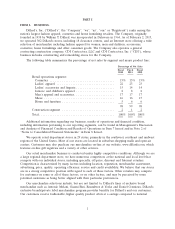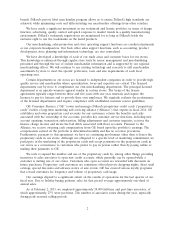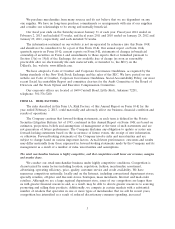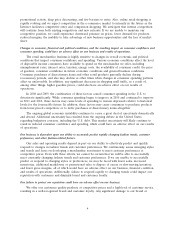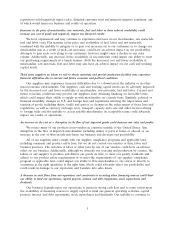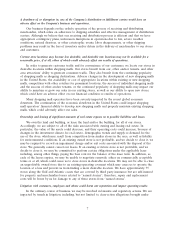Dillard's 2012 Annual Report Download - page 8
Download and view the complete annual report
Please find page 8 of the 2012 Dillard's annual report below. You can navigate through the pages in the report by either clicking on the pages listed below, or by using the keyword search tool below to find specific information within the annual report.promotional activity, deep price discounting, and few barriers to entry. Also, online retail shopping is
rapidly evolving and we expect competition in the e-commerce market to intensify in the future as the
Internet facilitates competitive entry and comparison shopping. We anticipate that intense competition
will continue from both existing competitors and new entrants. If we are unable to maintain our
competitive position, we could experience downward pressure on prices, lower demand for products,
reduced margins, the inability to take advantage of new business opportunities and the loss of market
share.
Changes in economic, financial and political conditions, and the resulting impact on consumer confidence and
consumer spending, could have an adverse effect on our business and results of operations.
The retail merchandise business is highly sensitive to changes in overall economic and political
conditions that impact consumer confidence and spending. Various economic conditions affect the level
of disposable income consumers have available to spend on the merchandise we offer, including
unemployment rates, interest rates, taxation, energy costs, the availability of consumer credit, the price
of gasoline, consumer confidence in future economic conditions and general business conditions.
Consumer purchases of discretionary items and other retail products generally decline during
recessionary periods, and also may decline at other times when changes in consumer spending patterns
affect us unfavorably. In addition, any significant decreases in shopping mall traffic, as a result of,
among other things, higher gasoline prices, could also have an adverse effect on our results of
operations.
In 2008 and 2009, the combination of these factors caused consumer spending in the U.S. to
deteriorate significantly. While consumer spending began to improve in 2010 and continued to improve
in 2011 and 2012, these factors may cause levels of spending to remain depressed relative to historical
levels for the foreseeable future. In addition, these factors may cause consumers to purchase products
from lower-priced competitors or to defer purchases of discretionary items altogether.
The ongoing global economic instability continues to cause a great deal of uncertainty domestically
and abroad. Additional uncertainty has resulted from the ongoing debate in the United States
regarding budgetary concerns, including the U.S. debt. This market uncertainty will likely continue to
result in reduced consumer confidence and spending, which could have an adverse effect on our results
of operations.
Our business is dependent upon our ability to accurately predict rapidly changing fashion trends, customer
preferences, and other fashion-related factors.
Our sales and operating results depend in part on our ability to effectively predict and quickly
respond to changes in fashion trends and customer preferences. We continuously assess emerging styles
and trends and focus on developing a merchandise assortment to meet customer preferences at
competitive prices. Even with these efforts, we cannot be certain that we will be able to successfully
meet constantly changing fashion trends and customer preferences. If we are unable to successfully
predict or respond to changing styles or preferences, we may be faced with lower sales, increased
inventories, additional markdowns or promotional sales to dispose of excess or slow-moving inventory,
and lower gross margins, all of which would have an adverse effect on our business, financial condition,
and results of operations. Additionally, failure to respond rapidly to changing trends could impact our
reputation with customers and diminish brand and customer loyalty.
Our failure to protect our reputation could have an adverse effect on our business.
We offer our customers quality products at competitive prices and a high level of customer service,
resulting in a well-recognized brand and customer loyalty. Any significant damage to our brand or
4


